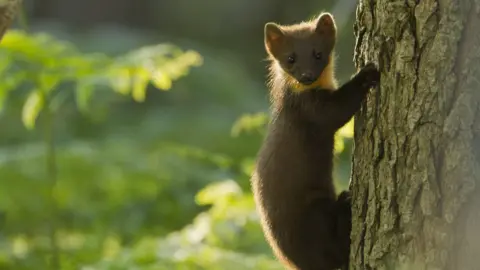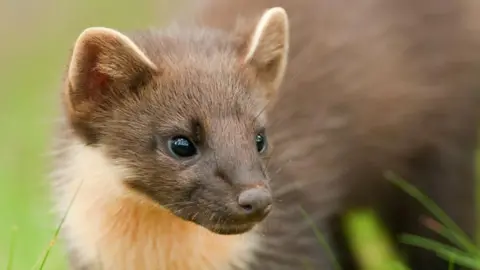Pine martens released into Lake District woodland
 The Wildlife Trusts/PA
The Wildlife Trusts/PAPine martens have been reintroduced into Lake District woodland in hopes to grow populations.
Eight females and five males were released into Grizedale Forest and the Rusland Valley, in a project led by the University of Cumbria and the University of Leeds.
Habitat loss and hunting pushed the mammals, which are related to weasels and otters, to the brink of extinction by the beginning of the 20th Century.
It is the first of two releases by the pine marten recovery project in a bid to boost numbers in their ancestral woodland.
 Dr Mic Mayhew
Dr Mic MayhewThe 13 healthy pine martens were moved under licence from strong populations in the Scottish Highlands, the University of Leeds said.
Researchers said it was assumed they had disappeared altogether in England until a rare sighting in 2022.
The project involves a group of landowners and organisations, including the Upper Duddon Landscape Recovery Project.
 Dr Mic Mayhew
Dr Mic MayhewProf Dominick Spracklen, from the University of Leeds' school of Earth and Environment, said camera traps have been set up and the mammals have been fitted with radio collars.
"It is exciting to watch their movements as they get used to their new home in the Lake District," he said.
 PA Media
PA MediaPine martens are excellent tree-climbers and are shy, nocturnal animals.
The habitat surveys and monitoring were led by Dr Mic Mayhew from the University of Cumbria, which found the most suitable area for release was the Grizedale Forest and the Graythwaite Estate.
"The good connectivity of woodlands in the area means that they might be expected to move quite quickly to other parts of south Cumbria including the Duddon Valley," Dr Mayhew said.
It comes as the Upper Duddon Landscape Recovery Project is exploring options for habitat restoration of native woodland, wood pasture, heath, scrub, and peat bogs.
It is hoped species including water voles, globeflowers, tree pipits and pine martens will grow in numbers.
Follow BBC Cumbria on X, Facebook, Nextdoor and Instagram. Send your story ideas to [email protected].
